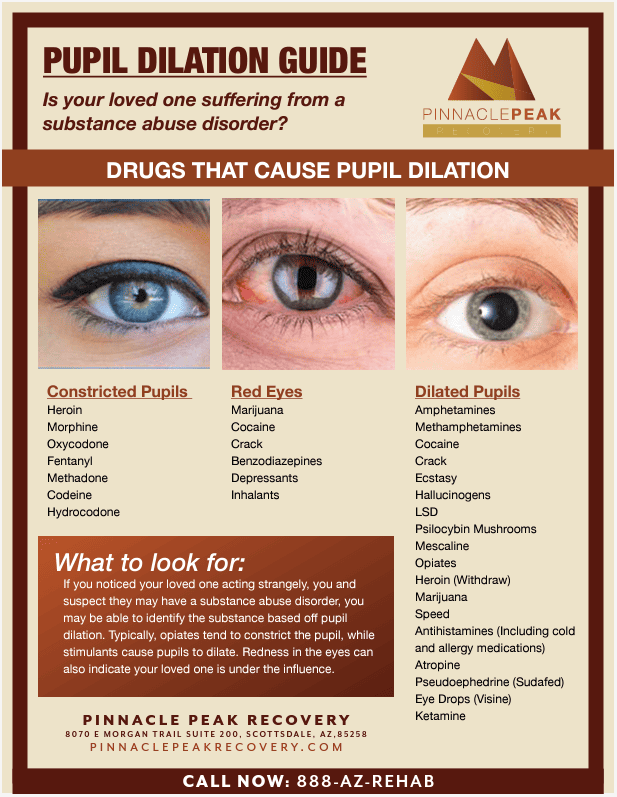One of the little-known side effects of substance use can be the impact it has on your eyes. Certain substances such as opioids can contribute to symptoms like pinpoint pupils. While heroin and opioid overdoses are still prevalent, synthetic opioid overdose has skyrocketed over the past years. How do these substances impact your eyes? How dangerous are pinpoint pupils? What changes in your eyes should you be aware of and which ones are cause for medical concern?
Here at Pinnacle Peak Recovery, we understand the importance of education when it comes to substance use and the potential side effects that can come from it. We aim to provide resources for our community so they can make informed decisions about their healing journey.
While many different substances can be the cause of pinpoint pupils, the most common cause is opioid use. There are other factors that can contribute to pinpoint pupils, however, and it’s important to know what those are in order to determine what level of medical help you might need.
Can A Drug Cause Pinpoint Pupils In The Eyes?
Our pupils shrink and expand naturally due to many things, the most common being the light levels around us or how closely we’re staring at an object, though they can also be impacted by emotions like excitement or by adrenaline.
When those factors are ruled out as possible reasons behind your pupils shrinking, it’s important to consider other possible causes. Pinpoint pupils are classified as pupils smaller than 2 millimeters in diameter. The primary reasons behind pinpoint pupils are:
- Substance use (opioids, benzos, heroin, fentanyl, nicotine)
- Prescription medications
- Toxins being in your system (such as insecticides or nerve agents)
- Horner Syndrome (which is usually caused by a stroke or tumor)
- Trauma to the eyes or brain
- Cluster headaches
- Diseases such as mumps, rubella, neurosyphilis, and more
In the case of substance use, substances that interact with the central nervous system or muscles in our body can cause the pupils to contract more than they normally would. Most of the time this is harmless. With the exception of sensitivity to light and potentially impaired or blurred vision, pinpoint pupils can occur in combination with an opioid overdose.
Pinpoint pupils can be an indicator that something is wrong with your health. If you believe your cause for pinpoint pupils might be trauma-related, or if you are uncertain of the origins of them, it might be a good idea to seek out medical advice.
Symptoms Associated With Pinpoint Pupils
One of the ways you might be able to determine the source of your pinpoint pupils, also known as miosis, is to determine what other symptoms you’re also experiencing. Pinpoint pupils rarely cause any symptoms on their own minus minor things such as blurry vision or light sensitivity. However, this doesn’t mean they shouldn’t be taken seriously if you notice them. Here are some of the reasons behind pinpoint pupils and some of the ways you can help identify their source.
Prescription Medications and Pupil Changes
In the case of prescription medications, you might not notice right away if you start experiencing pinpoint pupils. Not all medications have a chance of causing pinpoint pupils. Here are some of the most common medications that are known to have pinpoint pupils as a side effect:
- Alzheimer's medications
- High blood pressure medications
- Antipsychotic medications
- Antidepressants
- Prescription eye drops
- Zyprexa
If you or a loved one has pinpoint pupils, you might think this isn’t a cause for concern. However, if you believe your prescriptions are behind any changes being made to your eyes, it’s important to bring it up with your doctor in order to ensure that your medications, or any combination of them, aren’t causing you any additional harm.
Does Your Loved One Suffer From Side Effects Of Drug Addiction?
Let Us Help Them.
Cluster Headaches
Cluster headaches can be triggered by things like alcohol use, cigarette use, change in altitude, extreme heat, cocaine, bright lights, and over-exertion. While pinpoint pupils are one of the side effects of cluster headaches, there are other symptoms that can help you narrow down if what you’re experiencing is cluster headaches:
- Nasal congestion
- Red or watering eyes
- Sudden onset of pain, usually behind the eyes
- Eyelids drooping or swelling
- Sweating
Nicotine and Tobacco Use
Long-term cigarette smoking has been shown to contribute to a list of eye-related conditions, such as cataracts, ARMD (age-related macular degeneration), retinal vein occlusion, and miosis. Cataracts can lead to blurry vision and miosis is pinpoint pupils, both of which are treatable. ARMD and retinal vein occlusion, however, can be a bit more serious. ARMD makes you lose the center of your vision slowly over time. Long-term tobacco use has been shown to increase the speed at which this occurs. Retinal vein occlusion is the blockage of veins going to the eyes, which can lead to blindness if not treated.
Intracranial Hemorrhage
Also known as a brain stem stroke, an intracranial hemorrhage occurs when the blood supply to your brain is interrupted by a block or burst artery. Miosis in both pupils is a common symptom of this. Other symptoms to look out for include dizziness, vertigo, weakness on both sides of your body, slurred speech, sudden jerking or shaking, and unconsciousness.
Prescription Opioids & Overdose
In addition to pinpoint pupils, here are some other side effects you would experience in the instance of an opioid overdose:
- Difficulty breathing
- Pale or clammy skin
- Lips or fingertips start to turn blue or purple
- Non-responsiveness
- Unconsciousness
- Slowed heart rate
If you or a loved one is showing any of these symptoms, it’s important to seek medical help immediately.
What To Expect During Diagnosis
When going to a doctor in order to figure out the source of your miosis, there are a few things that will occur during your visit. The usual first step involves checking your pupils in a dimly lit room, as bright light naturally causes the pupils to constrict anyways.
If your doctor thinks you have pinpoint pupils (miosis) there are a few more things they will try to identify such as: if it’s impacting both eyes, if your eyes still react to light at all, do your pupils adjust when objects are closer to you, and how long does it take for your pupils to react.
It’s important to know that pinpoint pupils are not a disease, but rather a symptom of something else. Your doctor will then try to narrow down what the causes may be, from substance use to toxicity, to other diseases or injuries. It’s important to be honest with your doctor in order to make sure you receive the proper help you need.
Treatment Options For Substance Use Disorders
If your pinpoint pupils are caused by substance use and you’re looking for solutions, we offer those here at Pinnacle Peak Recovery. There are many other side effects that can occur with substance use disorder which can be more dangerous than pinpoint pupils alone. Long-lasting recovery is possible, and our goal is to get you there.
We offer everything from detox to residential care and intensive outpatient care. All of our programs are backed by trained medical professionals and promise a caring, family-feel to your treatment. We are passionate about our work here and want to see you succeed in your healing goals. We offer 12-step programs and other evidence-based treatment options to ensure you can pick a recovery path that works best for you.
If you or a loved one is looking to start recovering from substance use, or you have any questions at all, feel free to give us a call today at 866-377-4761.
Is Drug Addiction Harming Your Family? Give Us A Call To Start Their Recovery Process
FAQs About Drugs That Cause Pinpoint Pupils
When should you seek help for Pinpoint Pupils?
Pinpoint pupils can be a sign of something more serious, from stroke to opioid overdose. If you notice a change in your eyes or vision and you don’t know the source behind it, you should seek medical advice.
Can long-term substance use disorder damage your vision?
Long-term substance use can lead to many different ocular-based diseases such as cataracts, tardive dyskinesia, retinal occlusive disease, and blepharospasm. Many of these can lead to permanent vision damage and blindness if untreated.


